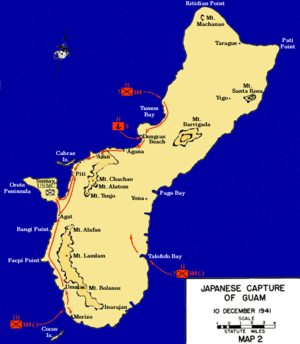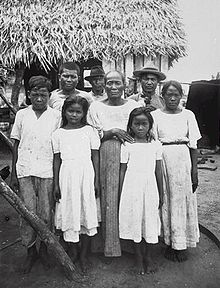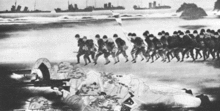Battle of Guam (1941)
Battle of Guam
Part of: Pacific War

Map of Japanese landings on Guam
Japanese offensives 1941-1942
1941Thailand
- Malay Peninsula - Pearl Harbor - Hong Kong - Philippines - Guam - Wake - Force Z - Borneo
1942
Burma - Rabaul - Singapore - Sumatra - Timor - Australia - Java - Salamaua-Lae - Bougainville/Buka - Indian Ocean - Port Moresby - Coral Sea - Midway - North America - Buna-Gona - Kokoda Track
The Battle of Guam was a landing operation by Japanese forces on the island of Guam, defended by U.S. units, during the Pacific War in World War II. The battle took place on December 8, 1941, a few hours after the attack onPearl Harbor, and cost the Japanese troops only one killed and several wounded. American troops, on the other hand, lost 17 men and several ships, plus the entire island garrison of about 600 men became prisoners of war.
Previous story
The two originally German Mariana Islands of Tinian and Saipan were conquered by Japanese soldiers as early as 1914 during the First World War. The Japanese units stationed there were combined into the "South Sea Defense Group" in 1918, and from 1935 foreigners were denied immigration and tourism permits; Japanese settlers from Hokkaidō colonized the two islands from the early 1930s, and by 1938 there were more Japanese immigrants on Tinian and Saipan than Chamorro natives. In addition to professional troops, a Japanese militia was raised, and Korean indentured servants developed the islands' runways into important air bases. A small detachment of the United Fleet became the 4th Fleet in 1939 and took over naval defense in the Marianas District.
The neighboring island of Guam, on the other hand, had been in American hands since 1898. In the course of the colonial war against Spain, American units occupied the island, and in the subsequent peace treaty, Guam was ceded by Spain to the United States. In 1899 military engineers built a workshop near the village of Piti, and two years later the U.S. Marines constructed barracks near Sumay. In 1905 coaling facilities and stores were built, and in 1909 a battery of 15-cm guns was brought to Guam from the Philippines. During the 1930s the central port of the island's capital, Agaña, was developed, with ship repair shops and a small dry dock; some U.S. Navy ships were stationed in the port, and thus could command the sea route north and south of the island. A naval captain, the highest-ranking officer on the island, was military commander of all units and, at the same time, official governor of the island, although the administration of each district was left to a civilian government.
Japanese preparations
The Japanese Empire had already targeted Guam militarily as part of the preparatory projects for the invasion of Southeast Asia and had been preparing an attack against the island since 1940. Troops were massed on the two neighboring islands, and naval aviators flew reconnaissance missions against Guam beginning in March. As the diplomatic situation between the United States and the Japanese Empire escalated even further, and the threat of open war was now officially accepted by both sides, the 4th Fleet raised the South Sea Force, which consisted of the 144th Regiment of the Imperial Japanese Army, various smaller units of the Navy, and a company of paratroopers. In parallel with this invasion force, a company of Maizuru Landing Forces (Kaigun Tokubetsu Rikusentai), an elite naval unit, was placed on standby on Saipan and trained for a landing. A support fleet with the 6th Cruiser Division was also assembled near Saipan.
American preparations
Because of the island's low strategic importance, it was to be defended by only a few units. Minor attempts were also made to reinforce Guam's small garrison before entering the war. The island's defenses were rated F: in the event of an attack, all useful installations were to be blown up, troops were to offer as much resistance as possible, and then surrender. Evacuation, relief or reinforcement plans did not exist. The island's governor nevertheless decided to establish initial defensive positions; in April the first of these were built in the interior; two Navy artillery batteries defended the port of Agaña, and another two the northern headland.
Between 17 and 23 October, about 1000 civilian construction workers and several hundred Pan American Airways and military administration employees were evacuated by a small destroyer flotilla. In November, all combat-ready men in the American colony were consolidated into the Guam Insular Force Guard (GIFG). In addition to the Insular Guard, there were two companies of Marines stationed on the island, both of which, however, were under debit, some disorganized units and the Navy artillerymen, and about forty volunteers, mostly engineers or untrained pioneers. Eighty Chamorros of the Guam Insular Patrol, a volunteer unit that served as police, were stationed on the island but did not participate in the battle and surrendered their weapons to the Japanese.
In all, there were 547 men on Guam. The Insular Guard and Marines were armed with the aging model Springfield M1903, 13 Lewis and 15 Brownings, while the sailors of the anchored ships had only Enfields M1917s and revolvers.
In the capital's harbor were two PT patrol boats, a minelayer, the USS Penguin, and an immobile oil tanker, the USS Robert L. Barnes. The Coast Guard vessel USS Goldstar was in Manila at the time of the attack to deliver Christmas gifts to Marines stationed there.

Chamorro natives on the Japanese-occupied island of Saipan
Battle
At 4:45 a.m. on 8 December 1941, the island's American governor, Vice Admiral George McMillin, learned of the attack against PearlHarbor; a few hours later, at 08:27 a.m., the first Japanese planes from Saipan attacked American military installations on Guam. The Marines' barracks, the docks at Piti, a radio station at Libugon, and two Standard Oil Company oil tanks were hit; the Pan American bureau was also attacked by Jabos and almost completely destroyed. Two Aichi D3As sank the USS Penguin in the air attack, killing one American officer and wounding another 22 sailors. The next day, the governor's residence at Agaña and various smaller targets, such as parked civilian and military vehicles, were also bombed.
At 7:00 p.m. on 9 December, the Japanese invasion fleet left the waters around Saipan: it consisted of four heavy cruisers, four destroyers, two gunboats, six sub-hunting boats, and two minesweepers, and brought with it some 5900 troops from various regiments. On the morning of 10 December, about 400 Japanese marines were put ashore at Dungcas, north of the island's capital. Immediately these troops were engaged in firefights with men of the Insular Guard, the Insular Guard having to retreat after a few minutes of fighting. The Japanese units captured the barracks at Sumay and advanced on Agaña via Piti: in the Plaza de España they got into a skirmish with American marines, Insular Guard men, and a few volunteers, but were quickly able to surround them. A few minutes after the fighting began in the city, all the Allied soldiers in Agaña had surrendered.
McMillin ordered the destruction of the most important documents, then barricaded himself and his staff in the entrance hall of his palace. Half a company of marines moved in to defend the residence, but McMillin saw that further fighting would have been pointless and went into captivity at 6:00. A few minutes later he signed the unconditional surrender of the island and its defenders.
The American Marines engaged in a few last-ditch battles with the Japanese Reserve troops who landed at 5:00 a.m. in various locations along the coast, but soon every unit on the island laid down its arms or was surrounded and disarmed by Imperial troops. Only naval officer George R. Tweed escaped and remained hidden in a cave until the American recapture of the island in 1944.

Japanese drawing of the landing of the imperial marines on Guam
Search within the encyclopedia